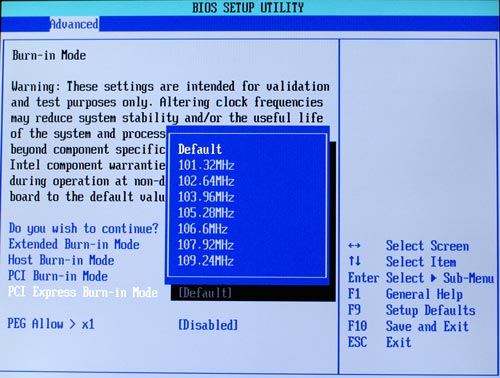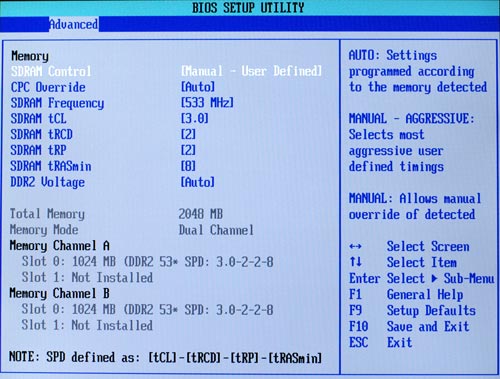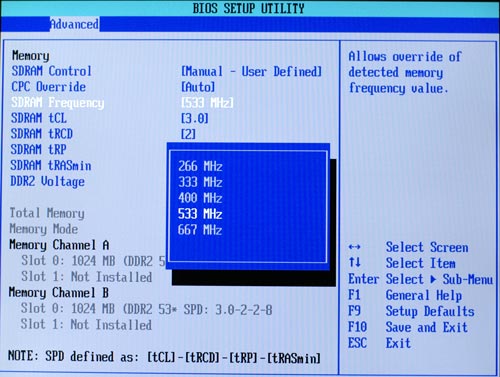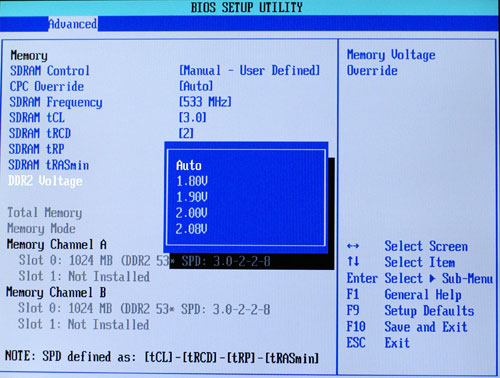Pentium 4 3.46 Extreme Edition and 925XE: 1066MHz FSB Support is Here
by Anand Lal Shimpi on October 31, 2004 3:00 PM EST- Posted in
- CPUs
Intel D925XECV2: Enthusiast Options
The new Intel 925XE includes adjustments for memory timings, memory speeds, memory voltage, and CPU FSB adjustments. These options are well-hidden in the Intel BIOS, but they are much more complete than you might expect on an Intel board.

The Main menu provides system information, but there is little indication of what is lurking inside the Intel BIOS. The real action for the Enthusiast is in the Advanced menu.

In the Advanced menu are the options to adjust PCI, Boot, Peripheral, Drive, Floppy, Video, USB, etc. The main controls for the Enthusiast are found in the Chipset Configuration menu

Chipset Configuration includes two important sub-menus - Burn-In Mode and memory

Continue and Extended Burn-In Mode should be enabled. You can then select Host Burn-In Mode.

Host Burn-In Mode now reveals an adjustment range of -2% to 10% in 1% increments. With a base frequency of 266 or 1066FSB, this is an adjustment range of 1045 FSB to 1173 FSB in 10.66MHz increments. While this is a very limited range compared to the average Enthusiast board, it is certainly a beginning for Enthusiast controls on an Intel board.

PCI speed can be adjusted form the default 33.33 to 36.36 and 40.0.

PCI Express also has an adjustment range from the default 100 to around 110 in 1.32Mhz increments.
Returning to Chipset Configuration, the Memory sub-menu has a wide range of memory adjustments.

After selecting Manual-User Defined you can select memory timings. This includes CAS Latency (tCL), RAS-to-CAS Delay, tRP., and tRAS.

DDR2 Memory Speed can be adjusted to base frequencies of 266, 333, 400, 533, and 667.

It was particularly surprising to find a reasonable range of memory voltage adjustments in the Intel BIOS. The available range is from default 1.8V to 2.1V. this is wide enough to allow many DDR533 rated DDR2 dimms to run at DDR667 or faster.
There are just two major controls missing for the Enthusiast. There is no option in the BIOS that we could find to adjust the base CPU frequency. If this could be forced to lower standard speeds such as 200 (800), there would be much more flexibility available for controlling the CPU. There is also no provision for CPU voltage, which is becoming less important as processor operating voltages have decreased. Our test CPU did have limited multiplier adjustments of 12X-13X but we do not know if shipping 1066 processors will also have this feature.
We could wish for wider ranges on several options, but the good news is this Intel board does contain the kind of tweaking controls Enthusiasts have been asking for from Intel.










63 Comments
View All Comments
AlexWade - Sunday, October 31, 2004 - link
Now if only I can afford and find one ...MMORPGOD - Sunday, October 31, 2004 - link
IntelUser2000 - Sunday, October 31, 2004 - link
DDR2 is not a stupid move, its the speed they are at that's stupid. Remember DDR? They first ones ran at 200MHz, which were 50% faster than PC133 and still way faster than the enthusiast 166MHz SDRAMs. DDR's latency were higher, but since their clock is much higher, it wasn't a big problem as DDR2 vs DDR. However, PC1600 DDR still was not a big improvement over PC133, it was when PC2100 came that DDR started to shine.Another thing:
Quote:"With the original 925X chipset we were a bit unhappy to see that the Pentium 4's 800MHz FSB was paired with DDR2-533, creating one of those frustrating asynchronous situations."
I think 800MHz bus with DDR2-533 is actually VERY synchronous. First look it doesn't look like it. However since DDR2s latency is higher, it doesn't act like DDR533, it acts like DDR400. There was a Tomshardware review that was trying to predict the performance of 1066MHz bus.
First config was: 800MHz bus, DDR2-533
Second: 1066MHz bus, DDR2-533
Third: 1066MHz bus, DDR2-667
Guess which one had the biggest performance benefit? The third one, contrary to most people's belief. I think that tells that because of the DDR2's latency, you need DDR2-667 to perfectly match 1066MHz bus. Since Intel chose to stick with DDR2-533, they have created an asynchronous situation, making the performance not so much better. They should have went DDR2-667 with 1066MHz bus.
SLIM - Sunday, October 31, 2004 - link
One thing I didn't catch from anand's review is that the 3.46ee is rated at 110.7 watts according to [H]; just another reason to go AMD. Makes you wonder what the 3.73ee (which is supposed to launch this quarter) will have for a heatsink...Prometia for everyone:)
Tides - Sunday, October 31, 2004 - link
I remember reading a week or two ago about "AMD is going to have a tough time keeping up," from the lips of an Intel guy.Was this latest outing with the new P4EE's the proof? Perhaps I lack the foresight to understand what will happen in 6 months time, but in who's world is AMD going to have a hard time keeping up with? Cyrix's?
Tides - Sunday, October 31, 2004 - link
"ddr2 is a stupid move."Tides - Sunday, October 31, 2004 - link
not to mention, hi, ddr2 for is a stupid move. high latency, crap bandwidth, not just twice the price since you wouldn't have had to upgrade your ram otherwise if you already had solid ddr1.it reminds me of rambus. and beta max. and sony's discman. what else? ddr2 should have never come out imo. ddr3 is where it's at, hopefully amd will go straight to ddr3 and save it's customers and themselves the hastle of having to buy new ram, new mobos and so forth just to have to do it again with ddr3. i like faster everything as much as everyone else, but amd 64 proves ddr1 is alive and well, and ddr2 is what? exactly? perhaps in a year down the road, or two; it'll be worth something at the end of it's life cycle, just as ddr3 starts poking it's head about.
GhandiInstinct - Sunday, October 31, 2004 - link
Why don't they just screw any other core and focus on pumping out $1000 EEs? Everyones buying them, might as well. I really would like to know the stats for Intel's sales on their new cpus and chipsets, exact numbers.GhandiInstinct - Sunday, October 31, 2004 - link
#17 I was infering this world is off balance with that reality...Gnoad - Sunday, October 31, 2004 - link
wow. $1000 a pop for a CPU that gets destroyed by processors that cost a quarter as much. Totally asinine.